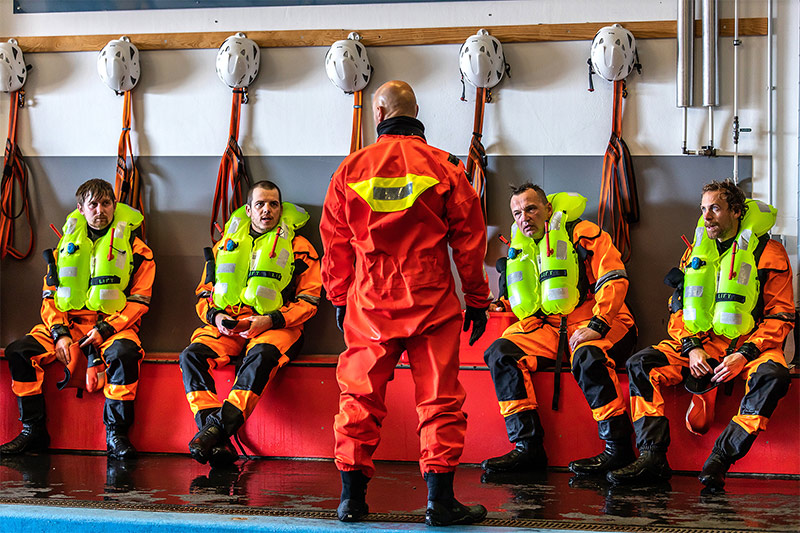Training to Survive
The "Horizons" logo of the German space mission is stuck to the front of the training helicopter. Below that is Alexander Gerst's autograph in white letters. In February last year, the prominent German astronaut was here for training. "A great guy," says Thorsten. The trainer at the RelyOn Nutec Center in Bremerhaven had the honor to train the astronaut and scientist in Helicopter Underwater Escape. Gerst is one of 10,000 course participants each year who are trained to deal with dangerous situations under and above the water, on platforms, at wind farms, on the side walls of ocean liners, or in rescue involving heights.
Alexander Gerst was not training for his next mission to the international space station. He was supposed to spend the winter on the German research ship, Polarstern, in the north polar ice before Covid19 times. In the fall of 2019, the German research icebreaker drifted through the frozen Arctic Ocean: the largest Arctic expedition ever undertaken, where scientists from 20 nations followed the Arctic over the course of the year. They overwintered in a region that is almost unreachable in the polar night. The natural force of the ice drift alone offers them this unique opportunity. Their research camp on an ice floe served as the basis for a half-mile wide network of measuring stations.
The aim of the expedition was to better understand the influence of the Arctic on the global climate. Hardly any other region has warmed more in recent decades. The expedition is considered a milestone in climate research. Important data for generations. An international fleet of icebreakers and helicopters supplied the team on this extreme route.
Theory is one thing
In order to be prepared for extreme cases and emergency situations, Gerst also trained in underwater exit from a simulated helicopter crash. "Everything is possible here," says Thorsten, swinging the training helicopter torso over the three meter deep indoor pool. Four men sit tensely in the seats of the simulated aircraft. After a big splash into the pool’s water, the training helicopter spontaneously descends and rotates vertically around its own axis. The cockpit floods in seconds. The crew hangs upside down in buckled seat belts. Don't panic now. Remaining calm in such situations, under water, head down, freeing yourself from the closed belts, takes practice. The preceding “theory is one thing,” says one of the course participants. "But putting it into practice..." He learned a lot. "An important experience" for the Siemens man. Two rescue divers observe and keep the training secure at all times.
Man overboard
RelyOn Nutec is one of the leading training centers for just such emergency situations. "We train in safety and survival training, primarily to support the onshore and offshore wind industry," says Jan Mahlstedt, Operations Manager at RelyOn Nutec. We are sitting in front of the company building located within a commercial port. At our feet, the artificial harbor basin created in the 18th century to compete with Bremerhaven. Opposite is the AWI, the Alfred Wegner Institute named after the discoverer of continental drift. The experienced team of trainers trains around 10,000 participants in Bremerhaven every year, including many customers from the seafaring industry and the oil and gas sector. The state-of-the-art training center with its own plunge pool and indoor climbing hall is packed with high-quality equipment. High-tech simulators and training equipment offer participants the most realistic training experience possible in a safe environment.
Later in the day, the boat takes you out to the adjacent harbor basin. "Man overboard," echoes the call from port. A rescue maneuver is immediately initiated as the next part of training. One participant keeps a close eye on the drowning dummy, the boatman turns and approaches the "drowning man" in a wide turn over starboard. The Jason's cradle smacks into the cold harbor water. The dummy is pulled in, rolled up and turned on board like a Swiss roll in baking paper. Maneuver complete! person saved! Amazing when you know how it's done and can handle the appropriate equipment on board.
Double backup
But what if such equipment is not available? Then there are other rescue techniques, the trainer explains, and waves everyone to port. "Lean overboard until the ship's side is almost at water level and then pull in," orders Thorsten. "Don't worry, a boat like this can withstand a lot and doesn't capsize so easily." But with this technology on board you should be careful of higher waves!
Next training to survive session: Docking at the offshore platform and safe exit from the boat at a height of 20 feet. You have to know what “double security” means. Every move has to be right. "That's important in order to do the right thing at the decisive moment," says Thorsten. RelyOn Nutec imparts the necessary knowledge and training every single day. The institute and its team of trainers are certified according to practically all criteria and standards. The offshore industry greatly relies on the training RelyOn provides as well as companies involved in plant security, the German Federal Agency of Relief (THW), various fire departments, and, of course, the prominent astronaut.








